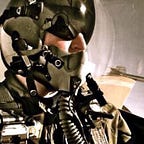Finding the Light
I spent the better part of 20 years thinking about landing jets on ships, preparing to land jets on ships, or actually landing jets on ships. During the day, this is the second most fun thing an adult can do, and most pilots can’t believe they get paid to do it. Conversely, there’s no amount of money that makes doing this in the dark seem worth it. That said, even in my relatively brief career, landing a jet aboard a ship at night became a lot easier thanks to various technological advances. But there aren’t any microprocessors, flight control computers, or upgraded displays that make a pilot’s job at night as easy as something much simpler — a full moon.
Throughout their careers, Navy pilots develop an intimate familiarity with lunar cycles, rivaled only by werewolves and astronomers. Few other groups tie their personal, professional, and sometimes spiritual lives so closely to lunar phases. During a deployment, working through the lunar cycle gives a pilot an odd way of passing monotonous days, weeks, and months.
Starting with a new moon, with the only illumination coming from faint stars, we know that’s the darkest it’s going to be all month. As the moon progresses through waxing crescent, first quarter, to waxing gibbous, most pilots feel less apprehension and more confidence. This peaks with the gift of a glorious full moon. These are the nights when some of the more “seasoned” pilots eagerly volunteer for night sorties…but it’s short-lived. After illumination peaks, the nights grow progressively darker and less comfortable. Murphy’s Law suggests this is usually when storms roll in, seas pick up, deck begins to pitch, and aircraft begin to act up. While waxing and waning phases are equal in length, it begins to feel like there’s an evil hand at work, slowing the clock on the backside of this heavenly cycle.
To deal with the discomfort and stress of these dark nights, pilots are taught to trust their flight instruments and prioritize objective data inputs over the strong temptation to follow a disorienting “seat of the pants” feel. When there’s no moon, no horizon, and poor visibility, it’s incredibly easy to develop vertigo or spatial disorientation. Sadly, this is exactly what killed John F. Kennedy Jr back in 1999. And while any pilot will concede that things are definitely harder in abject darkness, it’s never an excuse to fly an otherwise healthy airplane into the water…
Perhaps what makes all of this so fascinating, at least to me, is the parallel to life here on dry land, particularly in our country’s current environment. Depending on your personal preferences, political leanings, and station in society, you may believe the last few years have been the waxing phase. Or, perhaps it’s felt like the waning phase that might never end. You’ve gone to bed each night pleased that things are growing ever-brighter than the night before…or you’ve felt that things are getting darker, with any promise of a full moon frustratingly far away.
It seems to me the last few weeks have all of us, independent of our previous sentiments, commiserating with the pilot trying to land on a stormy, moonless night. It’s dark and nobody’s happy. And that full moon? It feels like we’re pretty far away from it. That evil hand has slowed the clock again, and we’re mired in darkness.
We the People must now do the same as that aviator at sea. We’ll only make it through this period of darkness if we muster the courage to set aside unnecessary distractions, choosing instead to make clear eyed decisions. We’ll survive this darkness if we choose to follow our flight instruments instead of that deceptive seat-of-the pants feel. We’ll get through this storm if we trust that those who’ve come before provided us plenty of tools for success, be those rules and procedures for flight or well-reasoned governing norms and civic standards. We’ll reach the other side of the metaphorical lunar cycle, if we remember that the airplane we’ve been flying all night, all month, all deployment, though it has dents and dings, is a pretty damned good machine, and we’d do well not to fly it into the water.
Jack
Views expressed are mine alone and do not represent those of the Department of Defense, Department of the Navy, or any other government agency.
